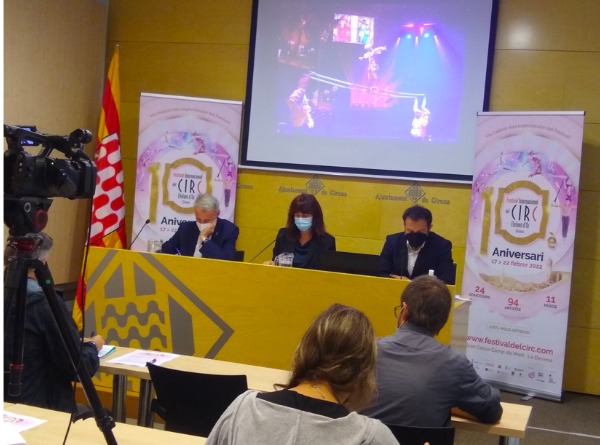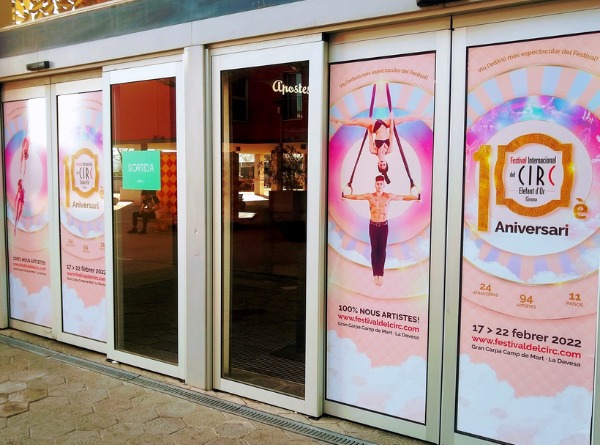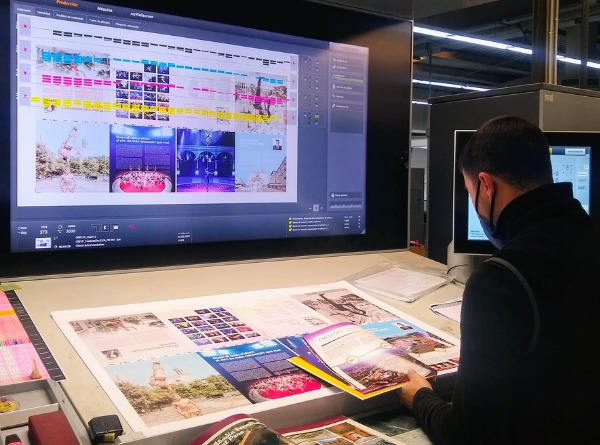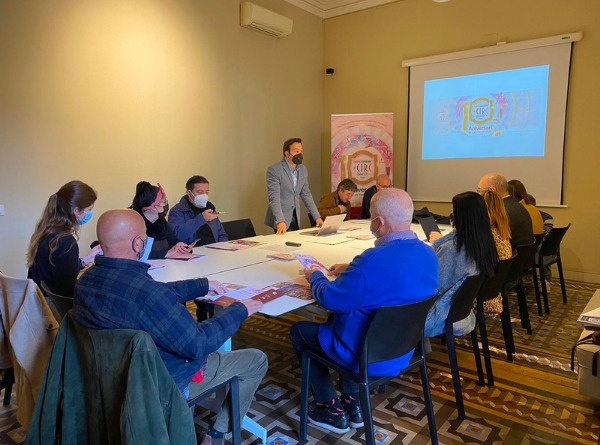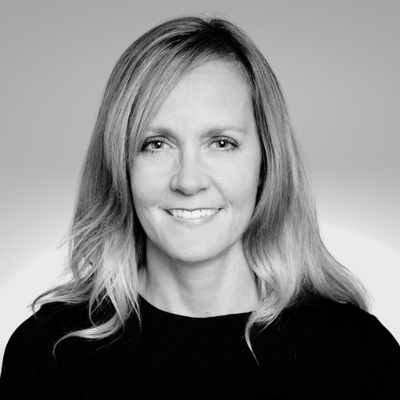Preserving Circus Past and Nurturing its Future: A Casting Conversation with Genís Matabosch
Genis Matabosch wears many hats in the circus world: impresario, festival director, artistic director, juror, author, historian, and ringmaster. On the 10th anniversary of theFestival Internacional del Circ Elefant d’Or, I had a chance to chat with him about his life in circus and his passion for circus history. We also discussed festival casting and Genís shared valuable insights and advice.
Genís Matabosch is the president of La Fondation du Cirque, founded ten years ago with a mission to promote high-quality circus in Europe.
The organization also created theInternational Golden Elephant Circus Festival (Festival Internacional del Circ Elefant d’Or), which celebrates its 10th anniversary this year from February 17-22, and prides itself on presenting acts that have never before been seen in Western Europe. The Golden Elephant Festival originally took place in the city of Figueres, relocating in 2018 to the city of Girona.
In addition to the festival, the Foundation programs two circus events every year: December’sCircus Christmas shows in the city of Girona and, in August,Circus Nights in Besalù, a village that is also home to Circusland, the European Circus Museum.
Stacy Clark (SC): Tell us about your role in all these fascinating projects.
Genís Matabosch (GM): I play a different role in each. I am in charge of the Festival’s artistic direction— that is to say, casting artists in our shows. Our casting approach has a totally different nature and profile for each production. So whether it’s the Christmas show,Circus Nights, or the Festival itself, we look for different talent profiles all year round.For these projects, I also take care of the technical production (which can be particularly heavy work, in the case of assembling tents), administration, and communicating with our sponsors and the press.
I am passionate about everything related to circus, but especially circus history. From 2000-2001, I trained as a curator at the National Institute of Paris, and today I am the curator of Circusland, where I oversee the exhibitions.
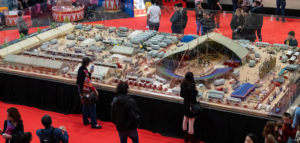
The Circusland project goes back a long time; I started writing the first proposal for the museum more than 20 years ago. Circusland aspires to be a memory house–- the memory of circuses from all over the world. My personal collection served as the basis for this project, which will soon celebrate its first anniversary.
We first tried to start the project in the city of Figueres, where we had held the first Golden Elephant festival, but didn’t get enough local support at the political level to develop it there. We got lucky once the festival moved to Girona, when we approached the people at the Monastery of St. Peter. The monastery is inBesalú, a medieval village— very touristy, very well-located— at a crossroads between the French border and Barcelona. It is a village visited by almost 1 million people every year.

On December 18, 2020, Circusland opened its doors with its permanent exhibition. That was the first phase of this project.Today, we boast a 1500-square meter exhibition, spanning three floors and 12 rooms, of circus history and all its disciplines. We have over 100,000 circus pieces from all over the world: everything from posters to postcards, autographs, and books; photos to videos; artists’ materials and costumes, and more. Visitors can discover rooms dedicated to the origins of circus, and see the largest model circus in the world: Germany’s Gleich Circus, which toured Europe 100 years ago. We also have halls dedicated to comedy, acrobatics, dressage, juggling, balancing, aerial disciplines, and magic.
And recently, we had a great opportunity to buy the Monastery’s old Benedictine kitchen garden, which is almost 10,000 square meters. That space will provide us with further opportunities to expand the project.
SC: What was your first connection to circus?
GM: I directed my first show, “Euroclowns,” in 2004 at the International Clown Festival of Cornellà, outside Barcelona. At that time, I was studying art history at the University of Girona, where I completed my degree thanks to a grant from an important Catalan bank based in Paris. After that, I took over as Director of the Cornellà Festival and, in 2008, I founded the Golden Elephant Festival in Figueres– the first festival of its kind in Spain. I was also the manager of several circus shows on tour in France, and brought them back with me to Catalonia.
But my love of circus started way before I started my career in it. I started collecting documents about the circus when I was 12, so in a way, I’ve been doing this job for 32 years now… Then again, when your job is your passion, it’s not really a job anymore. It’s more like asking a child not to leave his toy room! So I don’t sleep much, but I enjoy circus life a lot. It offers me so many emotions!
SC: Genis, you are not only casting and curating your own festival, but you also sit on the jury of many international competition-style festivals around the world, such as the ones in Russia, China, Budapest, Paris, and Monaco. Tell us about the jury process.
GM:So here’s the most important thing: the quality of the acts in front of us! Obviously, talking about “quality” can imply different things; different types of evaluation, one from both a technical and an artistic point of view.
As a jury, the first thing we look at is the act’s technical level. Everything that concerns the artist’s technique must meet certain required parameters in their respective disciplines.
But we don’t only look at that. We look at the whole artistic aspect of the act, whether it’s the costumes, choice of music, the movement, choreography, the dance…
We also look at narrative— that is to say, the story that a number tells—and aspects that go beyond the technical and artistic, such as the artist’s charm and stage presence. We’re talking about live shows, so it is very important for performers to connect with the public in a way and space that’s different from in the theater. In the round circus ring, where artists are completely surrounded by the audience, stage presence plays a very important role, especially in certain disciplines.
SC: How do you approach Girona Festival applications from artists performing the same discipline?
GM: There are a lot of acts from the same disciplines. We often receive several proposals for trapeze duos, aerial acts, straps, and fabrics, for example. And we always look at them from a technical and artistic point of view.
But mostly, it’s a question of originality. What makes one act different from all the others, even though they may be on the same technical level? Sometimes the only difference is in presentation, but sometimes there is also a difference in skill. So, what makes them original? What makes them stand out from the rest?
For Golden Elephant, we put a lot of emphasis on that question: what is new about this number? Sometimes it isn’t necessarily somethingnew, but rather something taken from circus history that’s become less common nowadays. A lot of acts have disappeared over the years, or are simply no longer done. History can be a source of inspiration.
I once heard a phrase that stuck with me: “You can’t be a good professional if you are not a good person.” This sentence made me think a lot and, in my experience, I think it’s very accurate. But it is true that people standing in the ring may only see the technical and artistic parts of our selection, and not so much the human end.
[Preparation for the 10th anniversary edition]
SC: Speaking of the human side, how does the human aspect inform your casting process?
GM: Before an act gets to participate in a show, they go through a whole process that starts with their proposal– with the artist submitting their video. Their professionalism outside the ring is taken into account during the invitation process. But what is also clear is that it’s just as important to be professional as it is to be human. A show is an ensemble. Therefore, it is very important to be “easygoing,” to be a “team player” during production. Then, of course, the artists get to know each other’s behavior outside the ring.
This aspect holds a lot of weight when it comes time to hire an artist for a longer period, like a tour that lasts several months. Often tours are long, with long working days as well. My pro tip for artists: the circus world is pretty small, and all the tour directors are in contact.
For Golden Elephant, we cast acts the conventional way, via video submissions from artists. We also have partnerships with large circus institutions, such as the state circuses in Mongolia; North Korea; and Russia, like the Bolshoi and Nikulin. And we collaborate with Chinese acrobatic associations. They help us find the rarest pearls: acts that have never before been performed in Europe.
We choose these acts either through video or during our travels, often within the framework of attending other large festivals. This part of the job is very important for us. Every year I watch hundreds, if not thousands, of videos!
SC: Demo videos! Any advice for artists on demo videos?
GM: Produce something that looks professional. It is a sure thing that the person who’s going to watch and evaluate your video will also judge its quality, because that says a lot about the artist. You need good lighting, without reflections.
Another tip: You should always have a demo, but also keep a complete video of the act without any editing, so that we can analyze it from start to finish. Often, we only receive demos, but an edited demo is not objective. Artistic directors and casting people want to see videos of your act uncut from start to end, and of good recording quality.
It’s also important to have high-quality photos and a complete CV, as well as all the documents you’ll need for the process of obtaining visas. This demonstrates a high level of professionalism from the artist.
SC: This can feel daunting for new and emerging artists. Any thoughts?
GM: We all start out with little. This is where originality and resourcefulness are very important. Of course, there used to be fewer companies that made professional recordings and videos. You can approach these companies— or even a freelancer— to help you produce a good recording. If you don’t have the money to pay for one yet, try to do a service exchange. You can offer them an artistic service in exchange for the recording, for example.
Even for those of us who have big infrastructures to work with today, we still do a lot of service exchanges ourselves. We have, for example, run some of our advertising campaigns on lesser-known radio stations. In exchange, we offer them tickets to our premieres. You really have to be open to that process.
With a nice presentation card, I think everything is possible, and finding the means to achieve it should not be an excuse for not having a good video or photos.
SC: How important is diversity in your casting, and how do you ensure equity during the casting process for the Golden Elephant festival?
GM: An international festival, as the name suggests, requires diversity. Our festival represents a dozen countries. Our main points of criteria for casting acts are, first of all, their quality, and second, to bring in acts that Europe hasn’t seen before.
It’s not our main concern whether we have seven different countries represented or 14. But it is true that it’s important to have a diversified line-up.
Diversity is not only about the number of countries you have on stage, but also about the disciplines you represent. It would be impossible to imagine a show with only aerial acts! As soon as you have a diversity of disciplines, it is natural to get a diversity of countries involved, because some disciplines are more country-specific traditions.
Today, I think we are seeing an explosion of solo and duo roller skating and aerial pole acts. You can see it in how many videos we receive. A few years ago, we didn’t even talk about those acts, since we received a video from one every six or seven years. Nowadays, at least every month there is a new solo act— usually male, on aerial poles, for example. It used to be like that with duo trapeze, then with fabrics. The same goes for acrobatic roller skating: we see more and more of it. It’s true that there are trends and waves like that.
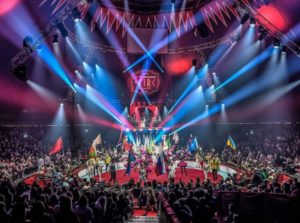
SC: Tell us about your views and philosophy on nurturing artists?
GM: Nurture is part of our mission. We often follow up with artists who aren’t accepted to the festival. Whenever we see an act, we find interesting points as much in the artist’s technique as their charm. But sometimes we’re not completely convinced to invite them, because we find that they have room for improvement.
We approach these cases in one of two ways: either we remain discreet and, without saying anything, accompany the artist’s progress from a distance, or we invite them to collaborate by putting our expertise at their service. If they agree, we offer them technical and artistic advice, without guaranteeing that their results will be okayed for the festival. But in general, these acts end up with us.
We have invited acts after seeing them in a video or performance online. Often we invite artists a year in advance. Why more than a year in advance, when sometimes casting for the current year is not even complete? Because we don’t want more than two acts of the same discipline in each edition of the festival. If you plan in advance, you can have pleasant surprises.
Once the artist is invited to the festival, it becomes an important motivation for them to multiply rehearsal hours and increase the level of our expectations for the performance.
We also receive acts at a level far above our expectations. For us, these are certainly the best surprises of our careers. For example, one year we had the Martinez Brothers, sons of a Colombian father and a Japanese mother. They perform an Icarian games act. We’d only seen a simple video of it before the festival, but in the meantime, they’d added a retractable platform that went up and down, like the ones used at construction sites. It let them give some great performances. Their act brought in something completely new— something that hadn’t ever been done in the history of circus.
So not only are we a platform that gives visibility to artists from all over the world, but we’re also a lever for encouraging them to improve. I think one value that’s important for circus artists to have is modesty, that thing that allows for constant self-criticism. We can always do better.
[Circus] takes a lot of work. The results do not come on their own, but through the strength and effort you put into it.
SC: How can participation in a circus festival enhance an artist’s career and resume?
The artists must not only prepare for their act, but also work on the ways they communicate it. That is to say, they must maintain a good network of contacts and feed their social media presence, for example, by having a good website, a good profile. It’s important to be talked about and to have visibility.
Another very important thing that artists should understand is that getting to be part of a festival is a prize in itself!
The most important prize given at any festival, in my experience, is not one granted by the jury. It is instead the casting team and artistic directors that offer it: it is the invitation.
It’s not the medal that counts, because a festival is a showcase. I think that, for an artist, the biggest prize is the magnitude of what being there represents for their career. Just being selected to participate by someone who spends all their time watching and choosing acts is already huge.
Unfortunately, many times we have seen artists completely upset when they do not receive a trophy in the festival finals. I don’t understand that at all. I think that, on the one hand, yes, there’s winning trophies, but there is also the fact of being seen. I think it’s a mistake to interpret not getting a prize as a failure or frustration.
[Festivals] allow artists to reach new horizons, like getting new contracts, new engagements. The acts that win the biggest prizes are sometimes the ones that have the fewest engagements later on. Excellent, simple acts that don’t win any trophies often get invitations after the festival that will lead them onto a successful career.
SC: Genis, thank you for sharing so openly, and for your meaningful—and practical— advice to artists who aspire to take part in festivals.
.
Genis Matabosch has an International Degree in Administration and Conservation of the Patrimony by the Patrimony National Institute in Paris and also a Bachelor in Arts History. Currently he is working on his doctorate at the University of Barcelona and he is the president of the Circus Arts Foundation based in Figueres. He is also an author of numerous exhibitions and publications about circus. He has been responsible for the management of the Catalan tours of the shows of circuses as Raluy, Moscow on Ice, National of Cuba, Medrano or Imagine. He is usually a member of the jury of the main International Circus Festival: Mexico, Moscow, WuQiao, Wuhan, Massy, Hanoi, Saint Paul, La Habana or Kiev. He owns the biggest Spanish collection of circus documentation and one of the main ones in Europe where thousands of pieces review the history of circus arts from its origins until today.
.
Images are courtesy of the Circus Arts Foundation and Festival Internacional del Circ Elefant d’Oro.
..
...
Do you have a story to share? Submit your news story, article or press release.


